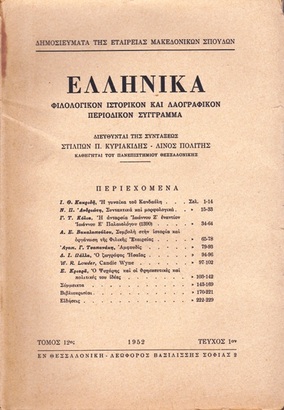Το λυκόφως των θεών στην ανατολική Μεσόγειο : Στοιχεία ανάλυσης για τρεις επιμέρους περιοχές
Part of : Ελληνικά : φιλολογικό, ιστορικό και λαογραφικό περιοδικό σύγγραμμα ; Vol.44, No.1, 1994, pages 31-50
Issue:
Pages:
31-50
Parallel Title:
The Twilight of the Gods in the Eastern Mediterranean : Analysing the Evidence for Three Distinct Regions.
Author:
Abstract:
After mentioning the methodological problems presented by the literary, legal and, especially, archaeological evidence regarding the Christianisation of the Eastern Roman Empire, the author chooses Greece, Constantinople and Syria, that is three areas highly dissimilar in geographical physiognomy, historical background and demographic synthesis, in order to study the progress of Christianity and the fate of paganism in late antiquity. It has long been established that the transition from paganism to Christianity in Athens was a slow and peaceful one. A study of individual sites in Greece shows that this picture applies to the region as a whole; the wide use by the Christians of holy pagan sities and buildings seems to indicate not a triumphalist attitude towards the pagan tradition, but rather an instinctive of continuity on the cultic, emotional and even theological level. Thus, if one excepts the very rare cases of acts of vandalism committed against particularly cruel gods, such as Nemesis, or obscene cults, such as that of Aphrodite, the general rule in Greece seems to be that the worship of the gods continued, albeit in a redefined and often unconscious manner. Despite the frequent assertions of Church historians that the religion of Constantinople had been unambiguous from the start, even a brief examination of the evidence reveals the new capital as a highly ambivalent place: not only was it surrounded by a strong pagan hinterland, but it was exposed from its foundation to a multitude of pagan sacred objects which were imported primarily for their aesthetic value. It is this combined influence on Constantinople which is responsible for the extraordinary symbiosis of the old and the new ways of thought and worship. Syria-Palestine, on the other hand, presents a picture of great violence during the process of its Christianisation. Behind the acts of vandalism against pagan temples, organised by the local bishops and carried out by monks and laymen alike, the author detects the anger of the indigenous populations against the symbols of a hated social and administrative order. It is a social rather than a «national» movement of those who had remained foreign to the ruling Greco-Roman culture. Indeed it is no accident that these same people were soon to be excluded from the orthodox tradition of the Church, a privilege henceforth to be reserved only for Greek speakers, that is for those whose cultural identity had been vaccinated by Hellenism.
Subject:
Subject (LC):
Notes:
Για χρήσιμες υποδείξεις κατά τή συγγραφή του άρθρου ευχαριστώ θερμά τους συναδέλφους Σόνια Καλοπίση, Θάνο Μαρκόπουλο, Κώστα Μπουραζέλη και Ευα Μπουρνιά




